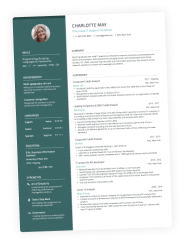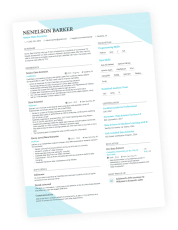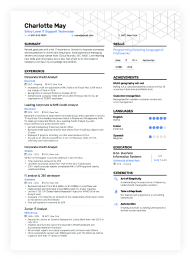More than a fifth of jobs require an advanced-level foreign language. If you want to stand out in an increasingly difficult job market, your second or even third language may be your secret weapon. However, understanding how to share language skills on your CV is the first step.
All too many candidates fall at the first hurdle. They describe their skills poorly, fail to add proper context, or even leave them off entirely, assuming they’re irrelevant. But when you harness the power of your language skills, they could make all the difference to your next application.
In this guide, we’ll cover all you need to know to show off your linguistic prowess. That includes positioning your CV language levels, describing them to recruiters, and standing out from the crowd.

Key takeaways
- Clearly stating your language level using a recognised scale like CEFR makes your CV more credible.
- Language skills can boost your chances with international companies—even if the job doesn't ask for them.
- Being vague about your abilities (e.g. "basic Spanish") can work against you. Aim to be specific.
- Lying or exaggerating your language skills is risky and can damage your professional reputation.
- Languages like German, French, and Spanish are highly valued by UK employers. So, mention them with confidence if you speak them.
Does your CV speak recruiters’ language? Find out by uploading it below:
Is your resume good enough?
Drop your CV here or choose a file. PDF & DOCX only. Max 2MB file size.
First things first, let’s start with a definition.
What are language skills on a CV?
Language skills on are your ability to speak, understand, read, or write in one or more foreign languages. That’s the basics. Sharing them on your CV shows employers how well you can communicate in different languages, and how that can serve their professional needs.
If you’re looking for an international contact, work in translation, or travel for your career, speaking a foreign language may be essential.

Examples of using language skills in the workplace
- Writing emails, reports, and client proposals in a second language
- Presenting to international clients or stakeholders
- Creating training materials or internal documentation in another language
- Liaising with multilingual teams across time zones
- Handling customer enquiries from non-English speakers
- Translating or proofreading content for global use
- Answering calls and providing support in a second language
- Supporting cross-border projects with real-time interpretation

Don’t exaggerate your language skills!
You’re not trying to impress a blind date, you’re applying for a job. There’s no room for showboating or bolstering your ego here. Instead, you need to be completely accurate about your skills.
Lying, or even bending the truth, is a real mistake. When you’re found out—and you will be found out—you risk losing your credibility or your job.
One of the biggest mistakes applicants make when sharing language skills on their CV is being vague. Simply listing “French” or “Spanish” won’t cut the mustard.
If you want to impress the reader, you need to be specific about your language talents. That’s where adding language levels to your CV comes into play. As we’ll discuss later in this guide, there are different frameworks you can use to describe your language abilities accurately.
But before we get down to the nitty-gritty details, we need to talk about why language skills matter.
Why language skills matter to UK employers
Before adding language skills to your CV, it’s important to understand why they matter. We won’t just give you one reason. We’ll give you four.
Here’s why you want to show off these talents:
International teams are becoming the norm
Applying to a multinational company? Language skills on your CV could give you a real edge. With international teams becoming the norm, your ability to communicate across borders can be invaluable.
Even if the job advert doesn’t specify needing a second language, the fact that you have one could set you apart from the crowd.
Communication with overseas customers is essential
Being able to speak a customer’s language directly improves service and trust. Whether you’re handling international sales or supporting overseas clients, language skills help you connect faster and avoid costly misunderstandings.
Employers know this—and often prioritise candidates who can bridge those communication gaps.
It shows a level of cultural awareness
Speaking another language isn’t merely about words—although, admittedly, that is a big part of it. It also shows you’ve made the effort to understand how people in other cultures think and live. This is an excellent soft skill for your CV, too.
You’ve stepped out of your comfort zone, something which employers always value. Plus, having a level of cultural awareness and sensitivity is a prime skill in pretty much any job.

Most in-demand languages for British professionals
Researchers at City Lit analysed job advertisements in the UK looking for multilingual professionals. The findings of the study revealed that the following languages were most sought-after:
- #1 German — in 25.5% of adverts
- #2 French — in 23.9% of adverts
- #3 Spanish — in 15.6% of adverts
- #4 Turkish — in 13.3% of adverts
- #5 Mandarin — in 3.6% of adverts
Do you have one of the above in the bag? Congrats—you’ve instantly upped your employability.
Next up, we’ll look at the best way to show language skills on your CV.
How to list language skills on a CV
How do you put language skills on a CV? If you want to get this right, you need to hit three marks. Your language skills should be:
- Easy to find on your CV
- Accurate (using a well-known scale)
- Brief and scannable
If you manage all of the above, the recruiter will have no problem finding exactly what they need.

Formatting tips for language skills on a CV
- Choose the right section for you. Depending on your experience and the role you’re applying for, you can pop your language skills in your personal statement, a dedicated language section, or your skills section.
- Add the proficiency level. Whenever you add a language to your CV, you should also include your level. After all, there’s a big difference between conversational speakers and fluent ones.
- Stick to a clear scale. When describing your proficiency level, always use the same scale. Don’t mix up frameworks when listing multiple languages.
- Prioritise high-value languages. If you speak a few languages, make sure you list them in priority order. Either start with your most fluent language or—in special cases—the language the job advert specified.
- Make it easy to scan. You don’t need to write an essay about your language skills. Instead, use line breaks or bullet points to make it scannable.
Be as clear and accurate as possible. Recruiters want to understand your CV language levels at a glance. The easier you make their job, the higher your chances of getting that all-important interview.

PRO TIP
You already know you need to tailor your CV to the job you’re applying for. Well, that goes for the languages you include, too. The first step is seeing if the advert mentions any languages.
But why not take things one step further? Research the company and see which markets it trades in. If you speak a language that aligns with the business goals, place that front and centre on your CV.
Now you’ve got a basic understanding of how to list language skills on a CV, let’s take things to the next level. There are different ways you can show off your proficiency, and we’re about to cover them.
Where to put language skills on a CV
Before you can add your linguistic competence to your CV, you need to know where to include this detail. There are five places you can mention your skills, and we’re going to look at each of them.
1. Languages section
If you’re highly proficient in two or more second languages—or it’s specified in the job advert—creating a dedicated language section is the way to go.
It’s especially useful for roles in international business, customer-facing roles, or global teams where multilingual communication is a clear asset.
Include a couple or a few languages, along with your level.
Take a look at our example:
This approach is straightforward. Don’t worry too much about the scale we’ve used in this example. We’ll be covering your options later in this guide.
However, if your language skills are more of an aside than the main focus, you can mention them elsewhere.
2. Personal statement
Want your language skills to catch the reader’s eye immediately? Slide it into your personal statement (e.g. your objective or summary) for the best results. This is often the first thing the recruiter reads, and so it’s sure to stand out.
There are a few situations where it makes sense to include your language skills in this section. If the language is a key selling point—for example, you speak Arabic or Chinese and it’s essential to the role—placing it here ensures the hiring manager sees it straight away.
On the other hand, you may need to save space on your CV, and can skip a dedicated section for your language skills.
Here’s a strong example of a CV summary where language proficiency is highlighted :
Shouting about your skills in this opening statement is a good place to start.
However, you should also expand on your language talents—and your level—in other sections of your resume.
3. Education section
If you learned a language at school or university, you can add it to your existing education section. Perhaps you completed a degree in French, or a module in Spanish. Whatever the case, list it in the same format as your other qualifications.
Check out an example of an education entry presenting a module in Italian:
- •Completed elective module in Italian language at A2 level
If you only completed a module, coursework, or a class, you might want to add a proficiency level. That way, the recruiter will immediately know how good you are at the language.
4. Competencies or skills section
Putting your language skills in a competencies or skills section is not your first port of call. However, you can use this space to elaborate on how you use your language skills on your CV.
Since you have the space to add more words, think of this as your opportunity to give the skills some context. For instance, you can include a caveat about the tasks you can complete in that language.
Use the exact language the employer has used. If they’ve stated they need someone to “present sales desks in French,” you may write the following:
Core Competencies
SharePoint Knowledge | Presenting Sales Decks in French | Problem Solving | Client Relationships and Retention | Tracking Leads | Public-Facing Work
Wording matters. If you’re not sure how to get the message across, go back to the original job advert and start there. Mimicking the recruiter’s language is a quick way to get them on side and demonstrate that you understand the demands of the role.
5. Certificates section
Of course, not all learning takes place at school or university. If you’ve taken courses—such as online training or night classes—you might want to add a certificates section to your CV. Describe the course you took, the levels you completed, the institute, and add the dates, too.
Let’s look at an example:
Now you know where to talk about your language skills on your CV, let’s delve into your level.
How to describe your language proficiency, explained
There’s more than one way to showcase your language proficiencies on your CV. First up, decide which framework to use.
We’ve broken down the main options below:
1. Plain English levels
Yes, one of the easiest options is to simply use plain English. Next to every language on your CV, add a single word to describe your level, like this:
- Native. Use this if you grew up speaking the language as your first or second tongue.
- Fluent. You can add this word if you speak, read, and write fluently.
- Proficient. The next level down works when you can hold conversations, but you’re not fully fluent.
- Conversational. Add this one if you can order a coffee or ask about the weather, but would be less comfortable having a full-blown interaction about in-depth topics.
- Basic. This is what it says on the tin. You’re at a basic level, meaning you understand some words and phrases, but haven’t taken things any further.
But is the simplest way the best? The short answer is no.
You can use plain English if you’re not sure what category you fall into. However, it doesn’t give the recruiter as much to go on as using a proper framework.
Here’s an example to make it crystal clear:
You can use this in a pinch, but it shouldn’t be your go-to.
Next up, let’s look at a more established option.
2. CEFR framework
Chances are, you’re familiar with the Common European Framework of Reference for Languages (CEFR). It’s the most commonly used system in the UK, largely because it’s so easy to understand.
Let’s break it down.
The CEFR organises proficiency levels into six categories: A1 to C2. The categories can be grouped like this: Basic User (A1–A2), Independent User (B1–B2), and Proficient User (C1–C2). Adding the appropriate level next to your spoken languages is a snappy way to get your point across.
Here’s what each level means:
- A1: You can understand basic expressions, introduce yourself, and answer simple questions.
- A2: You can handle simple, routine tasks in the language—e.g. ordering food and shopping.
- B1: You can deal with most travelling situations and speak about personal interests.
- B2: You can interact with a level of fluency and spontaneity in most situations.
- C1: You can express ideas fluently and clearly. You can also write clearly on most subjects.
- C2: You can express yourself fluently, even when speaking about complex topics.
If you’ve got a CEFR certificate, you should 100% use your proficiency level on your CV. But what if you haven’t?
So long as you’re honest about your level, you can use this framework as guidance for the recruiter. If you’re not sure where your skills land you, take a quick CEFR test now.
Check out how this option looks on a CV:
Most of the time, this is the best way of describing your language level. It’s recognised across Europe and will quickly let the recruiter know how fluent you are in each language.
But what if you’re applying across the pond?
3. ILR scale
The Interagency Language Roundtable scale—or ILR scale for short—is most common in the United States. It’s pretty easy to follow, ranging from 0 (no ability) to 5 (native or bilingual fluency).
Here’s a rundown of each level:
- 0: You have no ability, meaning you can’t speak or understand the language.
- 1: You know some words or phrases, but can’t hold a conversation.
- 2: You can handle simple interactions on familiar topics.
- 3: You can take part in most day-to-day conversations and have a basic grasp.
- 4: You can speak, read, and write the language in professional settings.
- 5: You can speak the language fluently, just like a native.
When you’re applying to roles in the UK or Europe, don’t use this scale. It is likely to confuse the recruiter and the CEFR framework is a far better option.
However, if you plan to get a role in the United States (especially a government position), this scale is the best way to go.
Let’s look at how you can lay it out:
Don’t make the mistake of simply listing the numbers. Make it clear for the recruiter by adding “ILR” next to it. That way, they’ll understand what scale you’re using for your level.
4. Language certificates
You’ve got the basics down—but what if you have certificates or qualifications in your chosen languages? Sharing your test results on your CV is a savvy way to get ahead of the competition.

PRO TIP
Um… not really.
Sure, you might have a 367-day streak (go you!), but DuoLingo doesn’t provide an official certificate. Adding it to your professional CV could look unserious.
If you’ve been using the app for a while, all is not lost. Do a CEFR-aligned test online and see what proficiency level you’ve got. List the level next to the language on your CV.
Wondering which certificates are likely to impress recruiters? We’ve got your back.
Check out some of the most well-known language qualifications:
- English IELTS (International English Language Testing System): The IELTS is a standard test for non-native English speakers. If English isn’t your first language, adding this qualification to your CV neatly shows off your language level.
- French DELF (Diplôme d'Études en Langue Française): DELF is the official language diploma, from the French Ministry of Education. It is recognised internationally, and may be required for some roles.
- Italian CILS (Certificazione di Italiano come Lingua Straniera): CILS is an Italian language exam created by the University of Siena. It uses the CEFR levels to check your ability.
- German Goethe-Zertifikat: Offered by the Goethe-Institut, this German language exam also aligns with CEFR levels. You might need it when going for jobs in German-speaking regions.
- Spanish DELE (Diplomas de Español como Lengua Extranjera): The DELE test is offered by the Spanish Ministry of Education and aligns with the CEFR levels again.
Adding these certificates to your CV seems like a no-brainer. Plus, if you’re applying for a job abroad, sponsorship, or a visa, you may find that one of the above is a requirement.
You can include these certificates in your education section or in a dedicated section, like this:
Your goal is to be honest and straightforward about your language proficiency level. Don’t make the mistake of fluffing the truth. Just add the appropriate level, and then move on.
When to use each language skills proficiency level
| Language framework | When to use it |
|---|---|
| Plain English | You have never taken a test. |
| CEFR framework | You’re applying to a role in the UK or Europe (and have taken a test to check your level). |
| ILR scale | You’re applying for a job in the US, especially with a government agency (and have taken a test). |
| Language certificates | You’ve completed official certificates in languages. |
If you’re just starting out and unsure how to describe your language skills on your CV, take a moment to think about the clearest and most credible way to present them. In most cases, the CEFR framework is your best bet.
Examples of language skills on a CV
By this point, you should feel pretty clued up on how to add language skills to your CV. Before we leave you to get started, it’s time for two examples: what to do, and what not to do.
Example of a badly written language section
Here’s what a bad example of language skills on your CV looks like:
The above language section doesn’t hit the mark, on three counts:
- The section heading is too casual (“Laguages I Speak”).
- The level text is full sentences, but should be a clear proficiency level.
- There is no consistency in how each of the languages is scored.

PRO TIP
Don’t be too clever for your own good.
It’s one thing to want to show off your language skills. But writing your whole CV in French or German? Yeah, that’s a really bad idea.
Even if you strike lucky and the recruiter is fluent in that language, you’re likely to alienate them. Plus, if the company is using an ATS, your application may get rejected before they even see it.
Next, let’s look at a languages section done right.
Good example of languages on a CV
Getting it right is easier than you might think. Simply follow the advice we’ve shared in this guide and use a solid framework.
Like here:
The above tick all of the boxes because:
- It’s clearly marked as a “Language” section.
- It includes consistent formatting.
- It uses a clear CEFR framework for the levels.
This approach makes the recruiter’s job easy as they can find out exactly what they need in seconds.
Takeaway
Having a choice of languages on your CV immediately boosts your employability. Whether you’re fluent in a second tongue or you’ve learned a little at school, be honest about your level. Why not get started now? Enhancv’s drag-and-drop CV Builder tool makes it easier than ever to highlight your skills.



